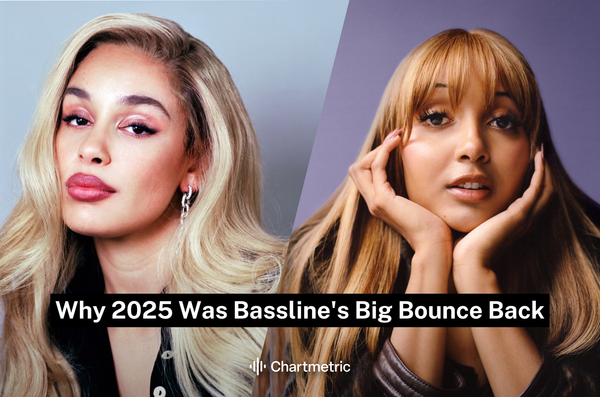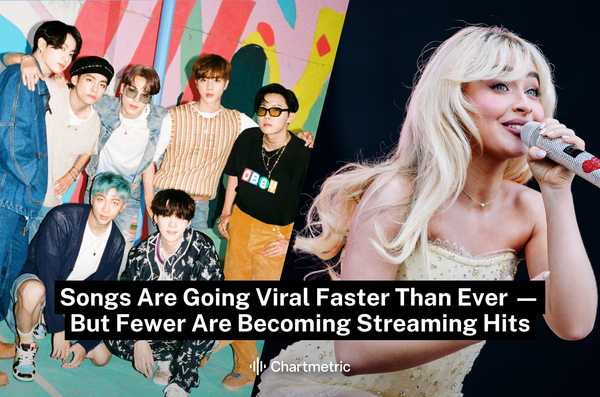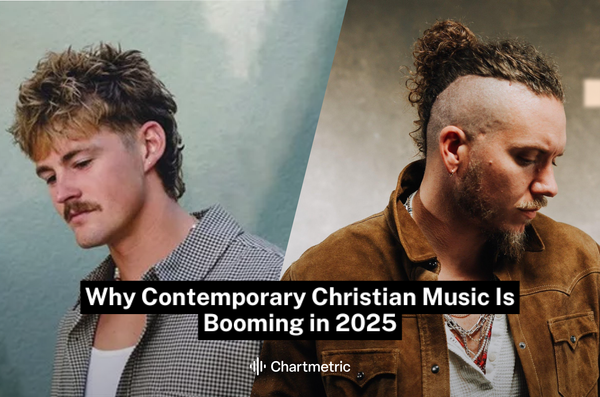Most of us know the story of how and why K-pop came to conquer the world, but are you familiar with P-pop, the Philippines' own pop phenomenon? What do you know about the newest generation of musical stars lighting up this archipelagic country? P-pop—or Pinoy pop, as it is sometimes referred—may share a naming convention with K-pop, and largely draws from idol culture in much the same way. Still, it has forged a unique identity of its own, blending Philippine mythology, bold visuals, universal storytelling, and regional Philippine languages into catchy bops, ice-cool raps, and heart-swelling ballads.
In recent years, a stack of genre-blurring pop acts have been freshening up the Philippine music industry, gradually bringing international attention to a rich musical heritage that spans more than 182 ethnolinguistic groups. Now, P-pop is claiming its spot on the global stage.
Last month, Baguio City’s alt-pop quintet Cup of Joe (Chartmetric rank: 2,265) made history as the first Filipino artist to cross the 10 million monthly listener mark on Spotify, gaining a foothold on the lower rungs of the Spotify Global Top Artists chart. For comparison, Nigerian Afrobeats VIP Wizkid (CM rank: 265) also counts 11.8 million monthly listeners while triple BRIT Award winner Rag‘n’Bone Man (CM rank: 1,131) currently has 10.22 million. Released in January, Cup of Joe’s big-hitting debut album Silakbo strays away from flashy or upbeat statements, switching up the group’s previous image to embrace a more vulnerable songwriting style. Its success, maintaining an impressive 77 points on Spotify’s popularity index, proves the extent to which a sense of authenticity and relatability can prevail.
Notably, Silakbo spawned a viral hit in “Multo” (“Ghost”), a reflective, ‘80s synth-tinged tune penned by Cup of Joe’s co-lead vocalist during the COVID-19 pandemic. “Multo” blossomed into a pop culture event, cresting six national charts in the Philippines and catching fire on TikTok, where its heartbreak content about struggling to move on from an ex has generated nearly half a million posts to date. It also made a splash on the US Billboard Global 200 chart, bolstering the claim that P-pop is breaking out at an international level. Not only did the single climb to number 80, but Cup of Joe significantly became the first Filipino artist to enter said chart.
“Tala” and Ground Zero for the New Wave
21st century P-pop—which has its roots in the 1970s-originating genre Original Pilipino Music (OPM)—has been on an upward trajectory since the late 2010s, a busy period that saw the emergence of Manila-hailing girl group BINI (CM rank: 1,993) in 2019 and boyband SB19 (CM rank: 2,786) in 2018, both trailblazers in their own right. It was also the era of "Tala,"Sarah Geronimo’s award-winning dance-pop sleeper hit which sparked a viral dance craze and metamorphosed into an anthem for the Philippines’ LGBTQIA+ community. Metrics-wise, "Tala" won Geronimo the distinction of being the first Filipina artist to hit the 100 million mark for YouTube (now with over 200 million views and nearly 62.06 million Spotify streams).
The much-loved SB19—aka Pablo, Josh, Stell, Ken, and Justin—also dropped their debut album, Get in the Zone (2020), via Sony Music Philippines during this fertile period, marrying EDM-style drops and bombast with smooth bilingual singing (largely in English and Tagalog, the latter being spoken by a large percentage of the population), rapping, and balladry. The following year, they became the first Filipino and Southeast Asian act ever to be nominated at the Billboard Music Awards, getting the nod for Top Social Artist thanks to their online presence, which now stands at an eye-watering 131.2 million TikTok likes and 694.86 million views on their YouTube channel. Today, SB19 also proudly lavish at seventh place on their country’s overall Chartmetric ranking.
BINI—who formed in 2019 through ABS-CBN’s Star Hunt Academy (SHA)—currently ranks at No. 1. In 2023, the girl group released their summery breakthrough single, “Pantropiko,” and they have been expanding their global reach ever since. Last year, they became the first P-pop act to perform at KCON, LA’s annual K-pop and Korean culture festival. The eight-member gang are currently at the ‘superstar’ stage of their career, placed among their country’s top 1% of artists on Chartmetric and ranking within the top 500 artists in the world last year.
Empowerment and Social Media Virality
BINI’s command of social media has been a major factor in their steadily intensifying superstardom. Winning the prize for humor and intimacy, the group’s content spans everything from choreographed ads for period pain medication to funny, heartwarming behind-the-scenes videos, and candid vlogs that dial in a direct line to their feelings. Alongside other girl groups such as KAIA and G22, BINI create sonic fanfares that “celebrate individuality” and “advocate for women's empowerment,” explains Ian Urrutia, founder of Nyou Public Relations Consultancy and The Rest Is Noise PH. “Through subtle yet impactful lyricism, they encourage young girls to embrace their inner strength and engage with broader issues affecting women and other marginalized communities today,” he tells Chartmetric.
@bini_ph Feel the beat, not the cramps! 🩷 #WorkItSis jingle is out and we’re excited to see your moves through our Dance Challenge. Put a period to period pain with Hyoscine N-butylbromide Paracetamol BuscopanVenus! If symptoms persist, consult your doctor. MAT-PH-2500401 / Ver 1.0 / DA 04-2025 / DM 04-2025 Opella Healthcare Philippines Inc. ASC REF. NO. S0160P042225B @Buscopan PH
♬ original sound - BINI PH - BINI PH
Social media platforms, notably TikTok and Instagram, have been “essential” in pushing the scene forward, argues James Gabrillo, a music professor at UT Austin and author of the 2024 book Pop Convergence: Musical Multimedia in Manila. “They’ve given fans unprecedented access and a real sense of community,” he suggests.
For Urrutia, social media has also played a pivotal role in extending P-pop’s influence beyond local borders. “These platforms have facilitated unprecedented levels of global connectivity, enabling P-pop acts to share content directly, cultivate personal connections, and foster a sense of community,” he explains. “This immediacy and accessibility have proven essential in building a more intimate, loyal fanbase—one that sustains domestic popularity and accelerates the genre’s international expansion.”
The open, accessible approach appears to be working well for BINI: data indicates that the group’s Instagram following has continued to grow steadily since March, increasing by nearly 25k in three months. Furthermore, they are expanding their social media fanbase beyond their home country. BINI’s Instagram follower count is split up across multiple countries, with the US accounting for 5.63% of the share and Canada, the UK, Japan, and the United Arab Emirates (UAE) also claiming a small proportion.
Looking at the bigger picture, this global expansion translates into the development of industry infrastructure and international partnerships. At the beginning of 2025, Filipino singer-songwriter Zack Tabudlo (CM rank: 3,736) signed with Universal Music Group (UMG) subsidiary Mercury Records while the International Federation of the Phonographic Industry (IFPI)—an organization that represents the interests of the recording industry worldwide—rolled out its Official Southeast Asia Charts, registering the official weekly music charts for six countries from the region, including the Philippines, for the first time. Last year saw the inaugural Billboard Philippines Women in Music Awards, 2021 saw the launch of Def Jam Philippines, and in 2022, Ingrooves teamed up with Curve Entertainment and Universal Records for a global distribution deal that aims to place local acts on the path to international fame.
Mixing the Old With the New
“There is immense value in starting local,” says Urrutia, who believes that the secret to P-pop’s success lies in its ability to ground itself in “an authentic understanding of Filipino tastes” and “cultural contexts”. We have seen this reverence for tradition play out in Alamat (which translates as “legend” or “folktale” in the Baybayin language); a six-person boyband who ‘aim to promote Filipino culture in everything they do’.
Comprising members from different regions across the country who often sing in their respective language, including Ilocano, Kapampangan, and Bicolano, Alamat fell within the top 200 "Singer/Songwriter" artists in the world last year and are fast growing their fanbase on social media. They often take inspiration from Philippine mythology and folklore, having depicted the singkil dance, a royal dance of the Maranao people, in their song "Maharani". They have addressed colonialism and racism in their work, exemplified by 2021’s future-facing single "kasmala,” which also weaves indigenous instruments into the song’s fabric: gongs and the hegalong, a wooden two-stringed lute played by the Tboli people of southern Mindanao. “What stands out about P-pop in 2025 is its evolution toward a more innovative and self-assured form. Increasingly, artists are venturing beyond formulaic templates to explore experimental and forward-thinking production ideas that resist the pull of fleeting trends,” offers Urrutia on the qualities that make P-pop unique.
Clearly, the P-pop industry is on a roll, evidenced by the upward-sloping lines of playlists Pinoy Pop Hits 2025, P-Pop on the Rise or OPM Rising and the emergence of new fandom sites like Poppin, which launched last month in an effort to make “P-Pop more accessible, celebrated, and recognized globally”.
“Comparing P-Pop’s trajectory with K-Pop’s explosive global success, K-Pop’s rise benefited hugely from South Korea’s structured cultural policies and sustained industry support. While P-Pop’s path seems more organic and decentralized, driven by passionate online communities and spontaneous social media buzz,” reflects Gabrillo.
“Looking forward, I see P-pop thriving precisely because it blends global ambition with a relatable local identity, allowing artists to connect locally while reaching outward. Rather than simply chasing K-pop’s blueprint, I think P-pop will carve its own meaningful, distinct niche,” he concludes.





